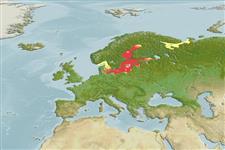Monoporeia affinis (Lindstrom, 1855)
| Native range | All suitable habitat | Point map | Year 2050 |

|
| This map was computer-generated and has not yet been reviewed. |
| Monoporeia affinis AquaMaps Data sources: GBIF OBIS |
Google image |
No photo available for this species.
Classification / Names Κοινά ονόματα | Συνώνυμα | CoL | ITIS | WoRMS
Malacostraca | Amphipoda | Pontoporeiidae
Environment: milieu / climate zone / εύρος βάθους / distribution range Οικολογία
; Υφάλμυρο; εύρος βάθους 10 - 80 m (Αναφ. 67162). Temperate
Distribution Χώρες | Περιοχές FAO | Οικοσυστήματα | Παρουσίες | Εισαγωγές
Northeast Atlantic: Germany, Sweden and Estonia, Baltic Sea.
Length at first maturity / Μέγεθος / Weight / Age
Γεννητική Ωρίμανση: Lm ? range ? - ? cm
Life cycle and mating behavior Γεννητική Ωρίμανση | Αναπαραγωγή | Γεννοβολία | Eggs | Γονιμότητα | Larvae
Main reference
Αναφορές | Συντονιστής | Συνεργάτες
Bonsdorff, E. and T.H. Pearson 1999 Variation in the sublittoral macrozoobenthos of the Baltic Sea along environmental gradients: A functional-group approach. Australian Journal of Ecology 24:312-326. (Αναφ. 95752)
IUCN Red List Status
(Αναφ. 130435: Version 2025-1)
CITES status (Αναφ. 108899)
CMS (Αναφ. 116361)
Threat to humans
Human uses
| FishSource |
Εργαλεία
Περισσότερες πληροφορίες
Διαδικτυακές πηγές
BHL | BOLD Systems | CISTI | DiscoverLife | FAO(Publication : search) | Fishipedia | GenBank (genome, nucleotide) | GloBI | Gomexsi | Google Books | Google Scholar | Google | PubMed | Δέντρο Ζωής | Wikipedia (Go, αναζήτηση) | Zoological Record


